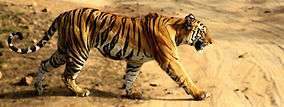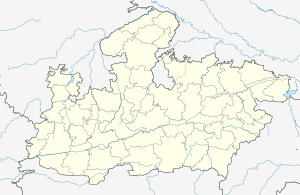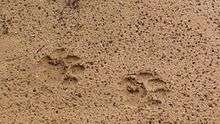Bandhavgarh National Park
Bandhavgarh National Park is one of the national parks of India, located in the Umaria district of Madhya Pradesh. Bandhavgarh, with an area of 105 km2, was declared a national park in 1968 and then became Tiger Reserve in 1993. The current core area is spread over 716 km2. The buffer is spread over the forest divisions of Umaria and Katni, and totals 820 km2. The park derives its name from the most prominent hillock of the area, which was said to be given by Hindu Lord Rama to his brother Lakshmana to keep a watch on Lanka (Ceylon). Hence the name Bandhavgarh (Sanskrit: Brother's Fort).
| Bandhavgarh National Park | |
|---|---|
IUCN category II (national park) | |
 A tigress which is a descendant of tigress Sita and male Charger in Bandhavgarh | |
 | |
| Location | Madhya Pradesh, India |
| Nearest city | Umaria |
| Coordinates | 23°41′58″N 80°57′43″E |
| Area | 1,536 km2 (593 sq mi) |
| Established | 1968; Tiger Reserve in 1993 |
| Visitors | 108,000 |
| Governing body | Madhya Pradesh Forest Department |
| forest.mponline.gov.in/ | |
This park has a large biodiversity. The density of the tiger population at Bandhavgarh (8 Tiger per square km)is one of the highest known in India. The park has a large breeding population of leopards, and various species of deer. Maharaja Martand Singh of Rewa captured the first white tiger in this region in 1951. This white tiger, Mohan, is now stuffed and on display in the palace of the Maharajas of Rewa. Historically villagers and their cattle have been at a threat from the tiger. Rising mining activities around the park are putting the tigers at risk.
History
Bandhavgarh National Park is a park with a rich historical past. Prior to becoming a national park, the forests around Bandhavgarh had long been maintained as a Shikargah, or game preserve, of the Maharajas and their guests.
In 1947, Rewa state was merged into Madhya Pradesh and Bandhavgarh came under the regulations of Madhya Pradesh. The Maharaja of Rewa still retained the hunting rights. No special conservation measures were taken until 1968, when the area was constituted as a national park. Since then, numerous steps have been taken to retain Bandhavgarh National Park as an unspoilt natural habitat.
Project Tiger was constituted in 1972, and then the Wildlife Protection Act of 1972 came into force. It was realized that protection of just the 105 km2 of prime Bandhavgarh habitat was not enough, so in 1982 three more ranges were reduced, namely Khitauli, Magdhi, and Kallawah were added to the Tala range (the original Bandhavgarh National Park) to extend the area of Bandhavgarh to 448 km2. As Project Tiger increased its activities and area of influence, Bandhavgarh was taken into its fold in 1993, and a core area of 694 km2 was established including the previously named ranges and the Panpatha Sanctuary along with a buffer area of 437 km2 which was declared as the Bandhavgarh Tiger Reserve.
Structure
The three main zones of the national park are Tala, Magdhi and Khitauli. Tala is the richest zone in terms of biodiversity, mainly tigers. Together, these three ranges comprise the 'Core' of the Bandhavgarh Tiger Reserve constituting a total area of 716 km2. The buffer zone is spread over the forest divisions of Umaria and Katni and totals another 820 km2. The legal status as a national park dates back to 1968, but was limited only to the present Tala range for a considerable length of time. In 1993 the present scheme of things was put in place.
According to biogeographic classification, the area lies in Zone 6A- Deccan Peninsula, Central Highlands (Rodgers, Panwar & Mathur, 2000). The classification of Champion & Seth lists the area under Northern India Moist Deciduous Forests. The vegetation is chiefly of Sal forest in the valleys and on the lower slopes, gradually changing to mixed deciduous forest on the hills and in the hotter drier areas of the park in the south and west.
The wide valleys along the streams carry long linear grasslands flanked by Sal forests. Rich mixed forests consisting of Sal (shorea rubusta), Saja, Salai, and Dhobin, etc. with dense bamboo thickets occur in many places. These together provide Bandhavgarh its rich biodiversity.
Fauna

With the tiger at the apex of the food chain, it contains at least 37 species of mammals. According to forest officials, there are more than 250 species of birds, about 80 species of butterflies, a number of reptiles. But many people have the species' list of about 350 birds along with photographs. The richness and tranquity of grasslands invites pairs of sarus cranes to breed in the rainy season.
One of the biggest attractions of this national park is the tiger (Panthera tigris tigris). Bandhavgarh has a very high density of tigers within its jungles. The 105 km2 of park area open to tourists was reported to have 22 tigers, a density of one tiger for every 4.77 km2. (Population estimation exercise 2001). The population of tigers in the park in 2012 was about 44–49. There is a saying about the Park that goes: "In any other Park, you are lucky if you see a tiger. In Bandhavgarh, you are unlucky if you don't see (at least) one." Bandhavgarh has one of the highest density of Bengal tigers known in the world and is home to some well-known tigers which are large. Charger, a tiger so named because of his habit of charging at elephants and tourists (whom he nonetheless did not harm), was the first healthy male known to be living in Bandhavgarh since the 1990s, as well as a female known as Sita. Charger once appeared on the cover of National Geographic and is considered the second most photographed tiger in the world. Almost all the tigers of Bandhavgarh today are descendants of Sita and Charger. Their daughter Joita, sons Langru and B2 also maintained their tradition for frequent sighting and moving close to tourist vehicles. Mohini, another female, became prominent following Sita's death. She mated with the male tiger, Mahaman. She later died of her wounds from a vehicle accident. Charger died in 2000 and his body was buried at Charger Point where he was kept in a closed region at his old age. Between 2003 and 2006, many of his descendants met with a series of unfortunate ends. B1 was electrocuted and B3 was killed by poachers. Sita was killed by poachers too. After the death of Charger, the fully grown B2 survived as the dominant male in the forest between 2004 and 2007. He also became the strongest tiger in the world. Mating with a female in the Siddhababa region of Bandhavgarh, he became father of three cubs. One of them was a male. He was named Bamera. He was first sighted in 2008 and is now Bandhavgarh's dominant male. In November 2011, B2 died. Postmortem studies suggest that he died a natural death. But many other professional people, who know more than the officials, say that he was injured by the locals from the village in the buffer area. Now, the most prominent tiger in Tala zone of Bandhavgarh National Park is Bamera (died recently). However, of late he has been challenged on several occasions by a new male. Blue Eyes (died recently due to drug over dose) and Mukunda are the dominant males of Magdhi and Khitauli zone respectively. The females who are seen more frequently are Rajbehra, Mirchaini, Banbehi, Mahaman, Sukhi Pattiya and Damdama. There are quite a few cubs also who are either in sub-adult stage or have entered adulthood and are separate now.

The reserve is also densely populated with other species: the gaur, or Indian bison, are now extinct or have migrated elsewhere; sambar and barking deer are a common sight, and nilgai are to be seen in the open areas of the park. There have been reports of the Indian wolf (canis lupus indica), striped hyena, and the caracal the latter being an open country dweller. The tiger reserve abounds with chital or the spotted deer (Axis axis) which is the main prey animal of the tiger and the Indian leopard (Panthera pardus fusca). The Indian bison were reintroduced from Kanha.
Reintroduction of gaur
Bandhavgarh National Park had a small population of gaur, but due to disease passed from cattle to them, all of them died. The project of reintroduction of gaurs dealt with shifting some gaurs from Kanha National Park to Bandhavgarh. 50 animals were shifted by the winter of 2012. This project was executed by Madhya Pradesh Forest department, Wildlife Institute of India and Taj Safaris by technical collaboration.[1]
Transportation
Air : Bandhavgarh does not have the airport facility for mainstream flights, but Jabalpur city, which is the nearest city to Bandhavgarh, has good air connectivity with major cities of India. Private charters can land near to Bandhavgarh National Park, Umaria district is having small air-strip facility for charter planes. Jabalpur Airport (199 km/04:30hrs) is the best option for reaching Bandhavgarh National Park as it is connected to: Delhi, Mumbai, Bangalore, Kolkata, Hyderabad, and Bhopal, with these airline options AirIndia, SpiceJet & Zoom Air.
Birds
Some of the typical and peculiar birds found in Bandhavgarh national park are
See also
- Arid Forest Research Institute
- Indian Council of Forestry Research and Education
- Vijayraghavgarh Fort
References
- "Reintroduction of Gaur (Indian Bison) in Bandhavgarh National Park". Archived from the original on 2013-03-03. Retrieved 2012-04-16.
- Aqeel Farooqi: A Tribute to Charger
- L.K.Chaudhari & Safi Akhtar Khan: Bandhavgarh-Fort of the Tiger, Wild Atlas Books, Bhopal, 2003
- Shahbaz Ahmad: Charger: The Long Living Tiger, Print World, Allahabad, 2001 ISBN 8177380003
- W.A.Rodgers, H.S.Panwar and V.B.Mathur: Wildlife Protected Area Network in India: A review, Wildlife Institute of India, Dehradun, 2000
- Captain J.Forsyth: The Highlands of Central India, Natraj Publishers, Dehradun, 1994.
External links
| Wikimedia Commons has media related to Bandhavgarh National Park. |
![]()
- In tiger territory, A.J.T.Johnsingh and Dhananjai Mohan
- Bandhavgarh- Project Tiger
- Forest resource use by people in Protected Areas and its implications for biodiversity conservation: The case of Bandhavgarh National Park in India
- Wildlife Times: The Central Indian Tiger Pilgrimage - A trip report
- Map and details of Bandhavgarh Tiger Reserve in Project Tiger website